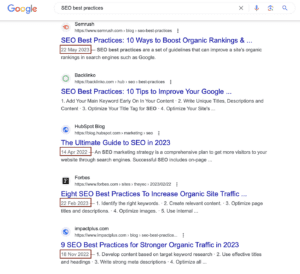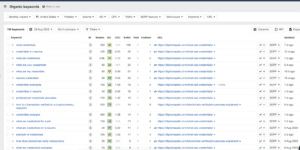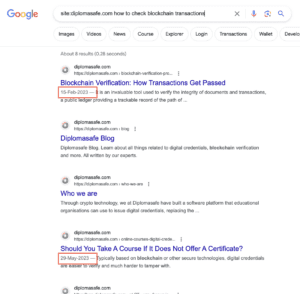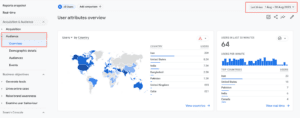In today’s Search Engine Optimisation (SEO) world, you are constantly thinking of creating brand-new high-performance content optimized to reach the right target audience. But, have you ever stopped to think about how your website’s pre-existing content affects your ranking in Google’s search engine?
While updating your website’s content with fresh, high-quality content is necessary for everyone’s SEO strategy, tapping into content pruning by weeding out low-performing content will benefit your high-performing content too.
Think of your website as a garden you want to see flourish when the seasons change. But for that to happen you need to weed — or prune — out the dying and unnecessary leaves and plants, leaving energy and focus on the healthy side.
Content pruning is a significant value growth strategy where content management leads to success in improving user experience and your website’s performance in search. Think of content pruning as a ‘less is more’ strategy: By removing outdated and irrelevant content, you ensure that consumers find the best content you have to offer, and Google can more meaningfully crawl your website.
What Is Content Pruning?
Content pruning involves cutting back on pre-existing content that may be outdated or low-traffic, allowing your best content to reach your users faster. This content could be outdated (especially content from 2020 and before, as so many industries drastically changed), contain irrelevant information, or duplicate content. By removing low-performing content from your website’s archives, you are cutting out that unhealthy “dead weight” that may be holding back your website’s content from flourishing.
Removing this outdated or low-performing content will also help improve how Google indexes your website since it prefers content that is the highest quality and up-to-date. Even though content pruning involves cutting out obsolete information, there are also benefits to updating, improving, and consolidating this pre-existing content.
Differentiating Content Pruning from Content Deletion
While removing those unranking pages from your site may improve the ranking of other content, simply deleting or shifting the content around without assessing its value can negatively impact your website’s metadata and URL structure.
This is content deletion, whereby you delete an entire page, which can interrupt some of your inbound links resulting in visitors seeing that dreaded “404 Page Not Found” message. Before simply deleting content or entire pages, it is important to conduct a content audit using tools like Ahrefs or Semrush to assess what pages are best to optimize or prune.
The Impact of Content Decay on SEO
What happens when your content starts bringing in less organic traffic than before? This is content decay – when Google starts prioritizing other, more relevant content that shows more up-to-date information to users.
As Google continues to change and update its algorithm — especially with the rollout of GA4 in July 2023 — it is important to optimize both new and pre-existing content to be as relevant as possible, to compete with newly published “fresh” content.
Essentially, the main consequence of content decay on search rankings is a decrease in organic traffic as your visibility in search drops, or other sites remove backlinks to your outdated information. According to SEMRush, organic search, and referral traffic like backlinking remain both the largest and most effective sources of ROI for their online content marketing strategies in 2023.
With this in mind, outdated content also affects user engagement and trust, but looking at user engagement rates can reveal which content is beginning to decay.
To illustrate, users are likely to open pages in search that are from 2023 or the earliest 2022. Of course, evergreen content remains valuable since it is not as time-sensitive as other content, and drives sustained traffic for a long time.
That’s why it is important to focus on your lowest-performing traffic and not necessarily your oldest content. Content from before 2020 can still hold some relevance, but sustainable SEO results of the content will still be considered if it has been updated recently.

The Benefits of Content Pruning for SEO
Not only does regular, strategic content pruning improve your overall organic traffic, but can have a ripple effect on other metrics you should be measuring like conversions, bounce rates, and time spent on the page. After the content pruning process, you should have more high-quality, fresh content that builds a sense of authority on a topic through high-quality, curated content.
Improved User Experience
By refining your content to showcase only the best, users are more likely to encounter your most relevant, up-to-date material. Think about it, Content pruning is a win-win strategy: With fewer posts or pages, users can more easily discover the high-quality content they seek. By removing low-value content, you amplify the impact of your top-performing pages.
More Effective Crawl Spend
Content pruning also helps Google find high-quality content that is fresh and unique. Google Analytics is a good starting point to get an idea of which pages are being crawled and contribute to organic traffic or lack thereof. By removing content that serves no value to your users, Google no longer has to sift through your old content and will make more meaningful crawls thanks to your pruning process.
Maintain Authority Through Backlinking
Backlinking should be a part of your SEO strategy, where only authoritative pages are being linked to. Whether you’re linking externally or internally to your other high-quality content, content pruning will ensure visitors that not only is your content valuable to them, but other leaders within your industry.
Tools and Analytics for Content Pruning
While the process of content pruning can be daunting if you have hundreds of pages, using free tools like Google Analytics and Google Search Console for an overview of all of your pages’ organic traffic is an excellent place to start before conducting a deeper content audit.
Let’s say you publish 3 blog posts a week. This means in a year you will have 156 pages with unique URLs and content to consider and later audit. Start by exporting this data from Google Analytics and Search Console into a Google Sheet, where you can gauge your pages’ or URL’s page views, value, bounce rate, and backlinks. This information will help identify which pages are underperforming and will inform your content pruning strategy.
While collating this data into a sheet is helpful for an overview of your pages, you should also add the goal of your page, (remove, repurpose, or update), your target audience, and which keywords you’re trying to rank for.
After gathering your page data, you are ready to use paid tools like Ahrefs and SEMRush for a more in-depth content audit where you will conduct keyword research, backlink analysis, and competitor research.
Determining the Frequency of Content Pruning
Many think content pruning is a single annual spring clean project when content pruning requires more regular monitoring, depending on how many pages you have on your site. According to SEMRush, 51% of companies say “improving content is the top tactic for gaining more organic traffic to their sites.”
Content pruning is a more periodic clean-up of your garden. The less frequently you tend to the garden and tidy up, the more time and space you give the deadweight and weeds to decay your garden’s content. Also consider Google’s algorithm updates as a sign to prune your content, as they have been known to impact organic traffic.
Step-by-Step Guide to Content Pruning Using Ahrefs
Let’s take a look at how using the Ahrefs Site Explorer tool can show us the top performers and underperforming pages for Diplomasafe, which helps educational organizations issue verifiable digital credentials.
1. Setting up Ahrefs for Content Analysis
For the content pruning process, Ahrefs recommends focusing your content audit on pages that are at least 6 months old, so that Google has had time to crawl and rank them for the organic keywords you are targeting.
For our Diplomasafe example, we are going to plug their URL into the Ahrefs Site Explorer to analyze the organic keywords report. Here we can view how their pages from at least six months ago rank for their primary target keywords.
Here, we can see Diplomasafe’s content is performing very well as it ranks in the top position for target keywords “what credentials”, and in the top 5 for “credentials examples.” Because these pages rank at the top of SERP, there is no content pruning required.

However, there are other pages from Diplomasafe ranking outside of Google’s top 20, like “micro credentials meaning” and “how to check blockchain transactions”, which means it might be time for the content to be updated.


2. Identifying Underperforming Content
Once you’ve started to identify which URLs are underperforming by filtering your organic keywords by position (from lowest to highest), create criteria to determine whether this page has achieved the goal it set out to reach. For your criteria, think back to whether the page was created to rank, what keywords it’s targeting, what position it currently ranks, as well as click-through rates (CTR).
One easy trick to identify why low-quality content might not be ranking in search is a quick site: search, to see if it is targeting unique keywords. For Diplomasafe, we’ve done a site: search for diplomasafe.com + resume certificates, to see how many of the pages are targeting these keywords.
This is where you decide the best course of action: to update the content or merge these pages and do a 301 redirect to shift the traffic to a consolidated page.
Sticking with Diplomasafe’s low ranking position for “how to check blockchain transactions”, we can see that the content isn’t necessarily the issue here because the content dates are fairly recent.

However, this raises important questions: Are there enough backlinks? Is the internal linking optimized? Is the metadata properly optimized for the targeted keywords? These are just a few of the many considerations that come into play when assessing the performance of your content. It’s not always about creating new content; sometimes, it’s about making strategic decisions to update, merge, or even remove existing content.
3. Deciding Whether to Prune or Optimize Content
So you’ve identified which content needs some attention. Now it’s time to use your best judgment and decide whether you are going to prune or optimize your content.
But, before deciding whether to prune or simply optimize your content, it is essential to distinguish between the two: Pruning your content means cutting away pre-existing content that causes your rankings to become stagnant, whereas optimizing your content is simply updating it to match search intent, ensuring on-page SEO is up to scratch, and the content is in-depth.
Factors to consider when deciding between pruning or updating content include looking back at the goal of the page and whether ranking for that specific keyword is valuable. Assess whether the low-performing content will bring any value to your visitors, and if it has any backlinks. If the content is neither valuable nor backlinking, it is best to delete it.
If the content isn’t getting any organic traffic, has no internal or external links, or cannibalizes other content, then pruning might be your answer. However, if you still want to rank that page or if it has outdated, thin information, optimizing the page with fresh, updated content can be a more effective route.
4. Implementing Content Pruning Strategies
Content pruning strategies include redirecting or consolidating URLs, hiding the page from Google’s indexing, or removing irrelevant pages. There isn’t a fast-track solution to content pruning, mainly if you haven’t conducted a site audit in a long time, but this will save you time and energy in the long run.
Generally, if a page hasn’t been attracting traffic for over a year, it should be pruned. But let’s say you have a few pages with low traffic, but the content remains relevant to your visitors – and probably requires some updated stats – rather merge this content into one stronger page instead of multiple dead-weight pages. Consolidating these previously smaller content pieces into a single, more in-depth page is better for sustainable SEO as it more easily satisfies Google’s desire for more detailed content, as well as taking some unnecessary weight off your page’s lackluster performance.
On the other hand, you may want to content prune by hiding pages from Google’s indexing bots but still want visitors to land on the page internally. This is because the content is valuable for your site’s visitors, but can be deemed useless by search engines. Here, content pruning requires technical input via inserting a noindex tag into your page’s metadata, which will make sure the page cannot be seen by search engines.
When turning to no-indexing, Google’s Developers say it is important to note that for your no-index to work, your website must not be blocked by robots.txt files as the crawler will technically never see your no-index in metadata. This means the content you are trying to hide from search engines can still appear in search engines if there is a backlink to it!
Robots.txt
To check if your site is blocked by robots.txt files go to Google Search Console and submit your URL to the robot.txt Tester Tool.
Deciding to delete your content comes down to whether it is irrelevant or has been replaced with more up-to-date content and valuable information. But, a note on deleting your content, it is wise to check whether these pages still have some valuable content that might be worth merging with other pages.
When choosing removal as your content pruning strategy, don’t forget to redirect the original URL to its updated counterpart on your current website. If you don’t redirect traffic, your target audience will hit a 404 Not Found page, which impacts your overall user experience.
Remember, content pruning is a periodic exercise and you shouldn’t delete all of your low-performing content too quickly. Instead, focus on deleting pages that are the absolute worst performers, and analyze the effects for a month before deleting more.
5. Monitoring the Impact of Content Pruning
Once you’ve kicked off the content pruning process, monitoring its effectiveness on your organic traffic and overall user experience will help gauge whether your strategy is the right choice. Because content pruning is more of a habitual process, making a habit of noting which dates you executed content pruning will help track any organic traffic patterns connected to your content pruning.
A simple way to note your changes made during content pruning is on Google Analytics.
On GA4, start by selecting “Overview” under the “Audience” heading, which will show your traffic. Ensure you have adjusted the date range on the graph to reflect before and during content pruning.

Previously, it was possible to create annotations in Google Analytics to mark when changes, like content pruning, were made. However, this feature is no longer available in GA4. Instead, you will need to monitor the impact of your content pruning efforts by regularly checking the key metrics such as users, sessions, bounce rate, and conversion rate.
Over time your website’s crawl spend would have decreased while clicks would rise because Google can index your website faster. But, at the beginning of your content pruning process, removing content from your website will impact your traffic, and would reflect on Ahrefs.
Continuous fine-tuning of the content pruning process will be essential once you start seeing results. Better yet, once you see positive results on your organic traffic after content pruning, you are likely to feel more confident in your content pruning decisions.
For example, after you’ve started deleting content, it is important to update your website’s internal links so that there is an uninterrupted traffic flow between your site’s pages. Since you know which content is the highest performing based on optimizing and pruning, making those periodic pruning decisions will become easier.
Conclusion
Content pruning can be a very rewarding content management strategy especially when Google continues to favor content that is high quality, relevant, and up-to-date. While content pruning takes time to see results, (like any worthwhile SEO strategy), reaping the rewards of periodic content pruning will be worth it in increased authority through backlinks and an increased CTR rate.
Consistently publishing high-quality, relevant content will also hopefully establish your website as a thought leader within your industry as more users trust your website, and others in your industry link back to you.
By tapping valuable tools like Ahrefs for periodic, effective content pruning, you will also have more peace of mind with less deadweight content weighing down your pages, creating more time and energy to focus on the top-performing content.


